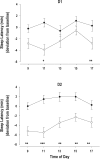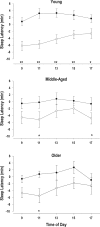Age-related reduction in daytime sleep propensity and nocturnal slow wave sleep
- PMID: 20175405
- PMCID: PMC2817908
- DOI: 10.1093/sleep/33.2.211
Age-related reduction in daytime sleep propensity and nocturnal slow wave sleep
Abstract
Objective: To investigate whether age-related and experimental reductions in SWS and sleep continuity are associated with increased daytime sleep propensity.
Methods: Assessment of daytime sleep propensity under baseline conditions and following experimental disruption of SWS. Healthy young (20-30 y, n = 44), middle-aged (40-55 y, n = 35) and older (66-83 y, n = 31) men and women, completed a 2-way parallel group study. After an 8-h baseline sleep episode, subjects were randomized to 2 nights with selective SWS disruption by acoustic stimuli, or without disruption, followed by 1 recovery night. Objective and subjective sleep propensity were assessed using the Multiple Sleep Latency Test (MSLT) and the Karolinska Sleepiness Scale (KSS).
Findings: During baseline sleep, SWS decreased (P < 0.001) and the number of awakenings increased (P < 0.001) across the 3 age groups. During the baseline day, MSLT values increased across the three age groups (P < 0.0001) with mean values of 8.7 min (SD: 4.5), 11.7 (5.1) and 14.2 (4.1) in the young, middle-aged, and older adults, respectively. KSS values were 3.7 (1.0), 3.2 (0.9), and 3.4 (0.6) (age-group: P = 0.031). Two nights of SWS disruption led to a reduction in MSLT and increase in KSS in all 3 age groups (SWS disruption vs. control: P < 0.05 in all cases).
Conclusions: Healthy aging is associated with a reduction in daytime sleep propensity, sleep continuity, and SWS. In contrast, experimental disruption of SWS leads to an increase in daytime sleep propensity. The age-related decline in SWS and reduction in daytime sleep propensity may reflect a lessening in homeostatic sleep requirement. Healthy older adults without sleep disorders can expect to be less sleepy during the daytime than young adults.
Figures




Similar articles
-
Dissociating effects of global SWS disruption and healthy aging on waking performance and daytime sleepiness.Sleep. 2014 Jun 1;37(6):1127-42. doi: 10.5665/sleep.3776. Sleep. 2014. PMID: 24882908 Free PMC article.
-
Neurobehavioral dynamics following chronic sleep restriction: dose-response effects of one night for recovery.Sleep. 2010 Aug;33(8):1013-26. doi: 10.1093/sleep/33.8.1013. Sleep. 2010. PMID: 20815182 Free PMC article. Clinical Trial.
-
Cognitive workload and sleep restriction interact to influence sleep homeostatic responses.Sleep. 2014 Nov 1;37(11):1745-56. doi: 10.5665/sleep.4164. Sleep. 2014. PMID: 25364070 Free PMC article. Clinical Trial.
-
Slow-wave sleep deficiency and enhancement: implications for insomnia and its management.World J Biol Psychiatry. 2010 Jun;11 Suppl 1:22-8. doi: 10.3109/15622971003637645. World J Biol Psychiatry. 2010. PMID: 20509829 Review.
-
Multiple Sleep Latency Test: technical aspects and normal values.J Clin Neurophysiol. 1992 Jan;9(1):63-7. J Clin Neurophysiol. 1992. PMID: 1552009 Review.
Cited by
-
The Influence of Sleep Quality, Vigilance, and Sleepiness on Driving-Related Cognitive Abilities: A Comparison between Young and Older Adults.Brain Sci. 2020 May 28;10(6):327. doi: 10.3390/brainsci10060327. Brain Sci. 2020. PMID: 32481581 Free PMC article.
-
Does working memory improvement benefit from sleep in older adults?Neurobiol Sleep Circadian Rhythms. 2019 Jan 18;6:53-61. doi: 10.1016/j.nbscr.2019.01.001. eCollection 2019 Jan. Neurobiol Sleep Circadian Rhythms. 2019. PMID: 31236520 Free PMC article.
-
Sleep in Normal Aging.Sleep Med Clin. 2018 Mar;13(1):1-11. doi: 10.1016/j.jsmc.2017.09.001. Epub 2017 Nov 21. Sleep Med Clin. 2018. PMID: 29412976 Free PMC article. Review.
-
Age-related abnormalities of thalamic shape and dynamic functional connectivity after three hours of sleep restriction.PeerJ. 2021 Jan 26;9:e10751. doi: 10.7717/peerj.10751. eCollection 2021. PeerJ. 2021. PMID: 33569254 Free PMC article.
-
Improving adjustment to daylight saving time transitions with light.Sci Rep. 2024 Jul 1;14(1):15001. doi: 10.1038/s41598-024-65705-x. Sci Rep. 2024. PMID: 38951618 Free PMC article.
References
-
- Foley DJ, Monjan AA, Brown SL, Simonsick EM, Wallace RB, Blazer DG. Sleep complaints among elderly persons: an epidemiologic study of three communities. Sleep. 1995;18:425–32. - PubMed
-
- NIH State-of-the-Science Conference Statement on manifestations and management of chronic insomnia in adults. NIH Consens State Sci Statements. 2005;22:1–30. - PubMed
-
- Groeger JA, Zijlstra FR, Dijk DJ. Sleep quantity, sleep difficulties and their perceived consequences in a representative sample of some 2000 British adults. J Sleep Res. 2004;13:359–71. - PubMed
-
- Kamel NS, Gammack JK. Insomnia in the elderly: cause, approach, and treatment. Am J Med. 2006;119:463–9. - PubMed
Publication types
MeSH terms
LinkOut - more resources
Full Text Sources
Other Literature Sources

